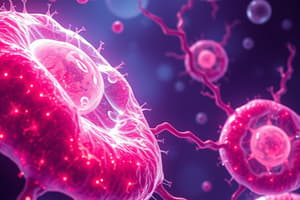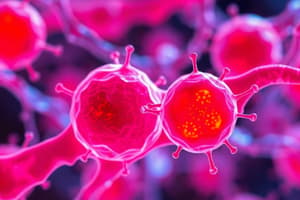Podcast
Questions and Answers
What is the primary characteristic of stem cells?
What is the primary characteristic of stem cells?
- They only exist in embryos.
- They can develop into specialized cell types. (correct)
- They cannot regenerate tissues.
- They are always differentiated cells.
Which type of stem cells can differentiate into nearly all cell types?
Which type of stem cells can differentiate into nearly all cell types?
- Pluripotent stem cells (correct)
- Multipotent stem cells
- Totipotent stem cells
- Unipotent stem cells
What does plasticity in stem cells refer to?
What does plasticity in stem cells refer to?
- The genetic makeup of the stem cells.
- The ability to repair damaged DNA.
- The ability of a cell to differentiate into various cell types. (correct)
- The capability to always remain undifferentiated.
Which of the following statements about induced pluripotent stem cells (iPSCs) is correct?
Which of the following statements about induced pluripotent stem cells (iPSCs) is correct?
Which statement about the differentiation of stem cells is true?
Which statement about the differentiation of stem cells is true?
What is the primary focus of the main course text mentioned?
What is the primary focus of the main course text mentioned?
What advantage is highlighted for completing the assigned textbook reading before class?
What advantage is highlighted for completing the assigned textbook reading before class?
Which resource is described as having detailed illustrations and clear captions?
Which resource is described as having detailed illustrations and clear captions?
Which characteristic distinguishes Clark et al., Biology 2e, OpenStax from the main course text?
Which characteristic distinguishes Clark et al., Biology 2e, OpenStax from the main course text?
How is the main course text available to students?
How is the main course text available to students?
Which technique is used to create induced pluripotent stem cells (iPS cells)?
Which technique is used to create induced pluripotent stem cells (iPS cells)?
What is the primary characteristic of induced pluripotent stem cells?
What is the primary characteristic of induced pluripotent stem cells?
Which of the following is NOT a source of pluripotent stem cells?
Which of the following is NOT a source of pluripotent stem cells?
What does the term 'therapeutic cloning' specifically refer to?
What does the term 'therapeutic cloning' specifically refer to?
What key feature distinguishes iPS cells from embryonic stem cells?
What key feature distinguishes iPS cells from embryonic stem cells?
What type of microscopy would be most appropriate for visualizing the detailed internal structures of a eukaryotic cell?
What type of microscopy would be most appropriate for visualizing the detailed internal structures of a eukaryotic cell?
Which of the following cell types can be observed using a light microscope?
Which of the following cell types can be observed using a light microscope?
Which cellular component is likely to be most easily visualized in a human blood smear?
Which cellular component is likely to be most easily visualized in a human blood smear?
What key difference typically distinguishes prokaryotic cells from eukaryotic cells?
What key difference typically distinguishes prokaryotic cells from eukaryotic cells?
In what way do human buccal epithelial cells differ from onion root tip cells?
In what way do human buccal epithelial cells differ from onion root tip cells?
What distinguishes prokaryotic cells from eukaryotic cells?
What distinguishes prokaryotic cells from eukaryotic cells?
Which of the following best describes eukaryotic organisms?
Which of the following best describes eukaryotic organisms?
Which of the following is NOT a characteristic of prokaryotic cells?
Which of the following is NOT a characteristic of prokaryotic cells?
Which of the following organisms is classified as a eukaryote?
Which of the following organisms is classified as a eukaryote?
What is the size range typical for prokaryotic cells?
What is the size range typical for prokaryotic cells?
Which of these components is present in both prokaryotic and eukaryotic cells?
Which of these components is present in both prokaryotic and eukaryotic cells?
What term is used for organisms that possess prokaryotic cells?
What term is used for organisms that possess prokaryotic cells?
Which statement about eukaryotic cells is true?
Which statement about eukaryotic cells is true?
Flashcards
Stem Cells
Stem Cells
Cells that can develop into other specialized cell types. They can be found in embryos and adult tissues.
Differentiation
Differentiation
The process by which a stem cell becomes a specialized cell type.
Plasticity
Plasticity
The ability of a cell to differentiate into various cell types.
Totipotent
Totipotent
Signup and view all the flashcards
Pluripotent
Pluripotent
Signup and view all the flashcards
Multipotent
Multipotent
Signup and view all the flashcards
Unipotent
Unipotent
Signup and view all the flashcards
Induced pluripotent stem cells (iPSCs)
Induced pluripotent stem cells (iPSCs)
Signup and view all the flashcards
Therapeutic Cloning
Therapeutic Cloning
Signup and view all the flashcards
Cells
Cells
Signup and view all the flashcards
Light Microscopy
Light Microscopy
Signup and view all the flashcards
Fluorescence Microscopy
Fluorescence Microscopy
Signup and view all the flashcards
Electron Microscopy
Electron Microscopy
Signup and view all the flashcards
Prokaryotes
Prokaryotes
Signup and view all the flashcards
Eukaryotes
Eukaryotes
Signup and view all the flashcards
Nucleus
Nucleus
Signup and view all the flashcards
Organelles
Organelles
Signup and view all the flashcards
Prokaryotic Cell Characteristic
Prokaryotic Cell Characteristic
Signup and view all the flashcards
Eukaryotic Cell Characteristic
Eukaryotic Cell Characteristic
Signup and view all the flashcards
Prokaryotic Cell Size
Prokaryotic Cell Size
Signup and view all the flashcards
Eukaryotic Cell Size
Eukaryotic Cell Size
Signup and view all the flashcards
Common Components of Prokaryotic and Eukaryotic Cells
Common Components of Prokaryotic and Eukaryotic Cells
Signup and view all the flashcards
Microscope Viewing Activity
Microscope Viewing Activity
Signup and view all the flashcards
Virtual Cell Building Activity
Virtual Cell Building Activity
Signup and view all the flashcards
Cell Size and Scale Exploration
Cell Size and Scale Exploration
Signup and view all the flashcards
Study Notes
Essential Principles of Biology
- Campbell et al.'s Biology: A Global Approach (10th edition) is a comprehensive textbook, detailed and packed with information, available at SUTD library and in cohort classrooms. Figures are detailed and clear.
- Clark et al.'s Biology 2e (OpenStax) is a supplementary, freely accessible resource, comprehensive yet suitable for all levels, with simple figures and illustrations.
Stem Cells
- Stem cells are undifferentiated or partially differentiated cells capable of developing into other specialized cell types.
- They exist in embryos and adult tissues.
- Differentiation involves gene activation and deactivation.
- Plasticity describes a cell's ability to differentiate into various cell types; totipotent, pluripotent, multipotent, and unipotent are varying degrees of plasticity.
- Pluripotent stem cells can produce all cell types and hold potential for regenerative medicine.
- Induced pluripotent stem cells (iPSCs), generated from adult somatic cells, are a promising stem cell source. Therapeutic cloning (somatic cell nuclear transfer) is another method.
Cell Structure and Organization
- Cells are microscopic and have complex structures and molecules.
- Visualization techniques include light microscopy, fluorescence microscopy, and electron microscopy.
- Living organisms are classified as prokaryotes or eukaryotes.
- Prokaryotes are simple, unicellular organisms like bacteria.
- Eukaryotes are more complex, unicellular or multicellular organisms including plants, animals, and fungi.
Prokaryotic vs. Eukaryotic Cells
- Prokaryotic cells lack a nucleus and other membrane-bound organelles; they are smaller (0.1–5 µm).
- Eukaryotic cells have a nucleus and membrane-bound organelles; they are larger (10–100 µm).
- Both prokaryotic and eukaryotic cells have some common components.
Mini-Activities
- Microscope viewing of human buccal epithelial cells, onion root tip cells, and human blood cells (RBCs and WBCs) to compare and contrast cell structures.
- Building a virtual eukaryotic cell (animal vs. plant).
- Cell size and scale exploration using online resources.
Studying That Suits You
Use AI to generate personalized quizzes and flashcards to suit your learning preferences.




